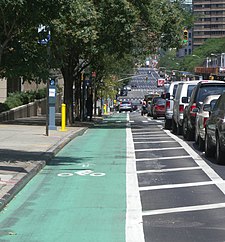First Avenue (Manhattan)
This article needs additional citations for verification. (September 2012) |
York Avenue (59th–92nd Sts) Pleasant Avenue (114th–120th Sts) | |
| West | Second Avenue |
|---|---|
| Construction | |
| Commissioned | March 1811 |
First Avenue is a north-south thoroughfare on the
History
Like most of Manhattan's major north-south Avenues, First Avenue was proposed as part of the Commissioners' Plan of 1811 for Manhattan, which designated 12 broad north-south Avenues running the length of the island. The southern portions of the Avenue were cut and laid out shortly after the plan was adopted.[3] The northern sections of the Avenue would be graded and cut through at various intervals throughout the 19th century as the northward development of the island demanded.
The
First Avenue has carried one-way traffic since June 4, 1951.[4]
The tunnel on First Avenue adjacent to the west side of the Headquarters of the United Nations opened to traffic on April 3, 1953.[5] This vehicular tunnel was constructed to provide a bypass for through traffic, reducing traffic volumes on the street level above the tunnel, which was intended to function as a local service road for the United Nations complex and the blocks on the west side of First Avenue.[6] The 1,377-foot-long (420 m) tunnel runs between portals at 42nd and 47th streets.[7] While the tunnel has always operated one-way in the northbound direction, it was originally designed to accommodate separate lanes for northbound and southbound traffic because First Avenue was a two-way street prior to the start of the tunnel's construction.[5] Work on the project commenced on August 1, 1949 with the relocation of the subsurface utilities that were located in the path of the tunnel.[8]
A protected bike lane was established along the left side of the avenue south of 50th Street in 2011.
Description
First Avenue passes through a variety of neighborhoods.
Starting in the south at Houston Street, First Avenue passes through the
Crossing under the Queensboro Bridge and entering the Upper East Side, First Avenue runs through a number of residential areas. It serves as one of the main shopping streets of the Yorkville neighborhood, historically a working class German and Hungarian neighborhood, today a wealthy enclave of upper-class residents. In this district, First Avenue is also known as "Bedpan Alley" (a play on "Tin Pan Alley") because of the large number of hospitals located nearby.
Crossing
First Avenue then connects to the Willis Avenue Bridge, which crosses the Harlem River at 125th Street and connects to Willis Avenue in the Bronx.
Transportation
The
The BMT Canarsie Line has a station at 14th Street.
In popular culture
- The opening scene of Ghostbusters II was filmed at the intersection of First Avenue and 77th Street.
- In the 1st Street as the "nexus of the universe". This provided the name for a nightclub called the Nexus Lounge at that location.[9]
Gallery
-
Bike lane on First Avenue
-
Looking south on First Avenue from 13th Street during the demolition of the Second Avenue El in September 1942
-
United Nations headquartersat First Avenue and 42nd Street
References
- ^ Google (September 1, 2015). "First Avenue (Manhattan)" (Map). Google Maps. Google. Retrieved September 1, 2015.
- ^ "First Avenue (Manhattan) - New York, United States". Yellow.Place. Retrieved February 7, 2023.
- ^ Stokes, I. N. Phelps (1928). The Iconography of Manhattan Island 1498-1909. Vol. 6. Robert H. Dodd. p. 1561.
[May 10, 1813:] The common council orders that First Ave. between 10th and 25th St. be opened and directs the proper officers to carry the same into effect—M. C. C. (1784-1831), VII: 458. On Nov. 1, the attorney was directed to open the avenue from 10th to North [Houston] St. as it would afford a short and direct route to Bellevue.—Ibid., VII: 596-97.
- ^ Ingraham, Joseph (June 5, 1951). "Autos Speeded 15% on 1st And 2nd Aves". The New York Times. Retrieved August 28, 2012.
- ^ a b "First Ave. Tube to Open". The New York Times. April 3, 1953. Retrieved August 14, 2023.
- ^ "Work Nearing End at U.N. Plaza Site". The New York Times. October 8, 1952. Retrieved August 14, 2023.
- ^ "Work Opens Today on 1st Ave. Tunnel". The New York Times. December 18, 1950. Retrieved August 14, 2023.
- ^ "Buried Utilities Near U.N. Must Go". The New York Times. August 1, 1949. Retrieved August 14, 2023.
- ^ Jaffe, Eric (July 7, 2014). "The Geographic Legacy of 'Seinfeld'". Bloomberg. Retrieved August 12, 2023.
External links
 Media related to 1st Avenue (Manhattan) at Wikimedia Commons
Media related to 1st Avenue (Manhattan) at Wikimedia Commons- New York Songlines: First Avenue, a virtual walking tour



